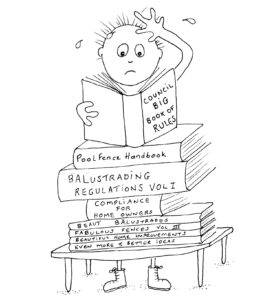Building regulations for balustrades & pool fencing

Whether you’re building a new home, managing a multi-storey development, or just freshening up a backyard deck, there’s one thing you can’t afford to overlook – compliance. And yes, we know “balustrade & pool fence regulations” don’t exactly spark joy, but they’re essential for keeping everyone safe and sound.
Why it matters
Correct design, installation and full compliance with the NCC isn’t just about passing inspection – it’s about making sure your project stands the test of time (and doesn’t land you in hot water later).
What is the NCC?
Building codes in Australia are determined by the Australian Building Codes Board (ABCB) and laid out in the National Construction Code (NCC). The NCC provides a consistent set of Australian building standards in the areas of health, fire, safety and sustainability. Below we have summarised some of the key points that relate to balustrades and fencing...
What is a balustrade and when do you need one?
A balustrade is a fall prevention barrier which must be provided alongside any stairway or ramp, any floor, corridor, hallway, balcony, verandah, mezzanine or path of access to a building if it is more than 1 metre above ground level.
Many accidents happen every year due to illegally built decks and balconies, or ones that haven’t been regularly inspected and maintained. Regulated decks, balconies and balustrades help to prevent these accidents from happening.
Building regulations in Australia state that balustrades should be a minimum height of 1 metre and have no spacings greater than 125mm to prevent large objects falling through.
For surfaces higher than four metres above the ground must have all of the above conditions must be met with the addition that they cannot have any climbable elements, such as horizontal rails, located between 150 millimetres and 760 millimetres from the floor.
Balustrades on stairs must be a minimum height of 865mm above the ‘nosing’ of the stair tread (see diagram below). Gaps in the balustrade cannot exceed 125mm.
Balustrades on stairs more than four metres above the ground must have all of the above with the addition that must also not have any climbable elements located between 150mm and 760mm from the floor.
Pool fencing rules in Australia – at a glance
Pool fencing regulations in Australia aim to prevent child drownings – but while the goal is clear, the rules themselves can be surprisingly complex.
National Standard
Although the standard is based on AS1926.1, which sets out requirements for fence height, gaps, gate latches, and non-climbable zones, each state and territory interprets and enforces this standard slightly differently. However, some key requirements are generally consistent:
- Fence height: Minimum 1.2m.
- Gaps: Less than 100mm
- Non-climbable zone: 900mm clear around the outside of the fence
- Gates: Must self-close and self-latch, with latch positioned out of child reach
- Direct access from the home is restricted or requires compliant safety measures
Where It Gets Tricky
Rules differ between states (e.g., VIC inspections every 4 years, NSW requires certificates to lease or sell).
Older pools, spas, and portable pools may follow different rules.
Site specifics – like sloping blocks or shared boundaries – can affect compliance.
Landscaping or renovations can unintentionally make a compliant pool non-compliant.
Even small changes can affect pool safety compliance. Given the layers of regulation, it's often best to get expert advice to ensure everything’s up to standard.
Climate
You might not have thought about it, but climate plays a significant role in the selection of materials for balustrades, particularly in Australia where conditions can vary greatly between regions. When planning new construction or extensions, one of the first considerations is whether the site is located in a bushfire-prone area, as this will directly influence material choices and compliance requirements.
For bushfire-prone areas, construction must comply with one of six Bushfire Attack Levels (BALs), ranging from BAL Low to BAL FZ (Flame Zone). Each level sets out specific requirements regarding the materials that can be used. As the BAL increases, so too do the restrictions on flammable materials.
Metal is the safest and most universally accepted option for balustrades in bushfire zones, as it is non-combustible and suitable for use across all BAL ratings. However, if you prefer the aesthetic of timber, certain hardwoods can be used within specific BAL ranges. For BAL Low to BAL 19, only timber with a minimum density of 750 kg/m³ is permitted. In BAL 29 areas, timber must not only be high-density but also recognised for its fire-resistant properties. Suitable species include Merbau (Kwila), Spotted Gum, Blackbutt, Turpentine, Red Ironbark, River Redgum, and Silvertop Ash.
Beyond fire risk, coastal environments introduce additional challenges. Exposure to salt-laden air, wind, and sand can accelerate corrosion in steel, attack low grade or improperly prepared powder coat finishes, or degrade unprotected timber. In these locations, it’s crucial to select materials that can handle the conditions, like high quality 316 stainless steel of a suitable polish, a suitable grade primer and powdercoat, and the right timber finishes to extend the life and structural integrity of your balustrades or fences.
Opportunity for Collaboration
We are seeking visionary investors and manufacturing partners to join us in bringing a dynamic new product to a broader market. With a proven track record and a commitment to innovation, this partnership offers an opportunity to be part of a venture poised for significant growth.